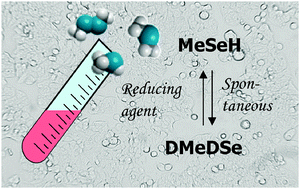The aim of this study was to identify the presence of MeSeH in metabolic reactions. An analytical method based on direct headspace GC-MS, eliminating loss of volatile species during sample pretreatment procedures, was developed for this purpose. The in vitro conversion of selenium compounds to the volatile species methylselenol, MeSeH, dimethyl selenide, DMeSe and dimethyl diselenide, DMeDSe was investigated. The analytical method was evaluated by means of standards of dimethyl diselenide, dimethyl selenide. The corresponding sulfides were found unsuitable as internal standards as they interacted with the selenides. The limit of detection was 0.25 μmol L−1 (20 μg L−1) for the selenide as well as the diselenide. Formation of MeSeH was not observed in significant amount when selenomethionine was incubated with the enzyme L-methionine-γ-lyase; instead large amounts of DMeDSe were formed. In aqueous solution, methylseleninic acid, MeSeA reacted spontaneously with glutathione, GSH to form DMeDSe. In strongly reducing environments, however, MeSeH was also observed. When the formed MeSeH was trapped with iodoacetic acid, no DMeDSe was detected indicating that DMeDSe formation was due to spontaneous oxidation of MeSeH. These findings imply that DMeDSe may be a marker for the production of MeSeH in in vitro models. When MeSeA, Se-methylselenocysteine, Se-MeSeCys and SeMet were incubated with Jurkat cells, DMeDSe formation was only observed in the case of MeSeA. Trace amounts of DMeSe was observed in the vial with MeSeA as well as Se-MeSeCys. When DMeSe and DMeDSe were added to plasma, the sensitivity of only DMeDSe decreased significantly, implicating that DMeDSe underwent a reaction with plasma hindering the volatilization. This emphasizes that results from in vitro selenium metabolism studies may not be uncritically interpreted as consistent with the in vivo reality.


 Please wait while we load your content...
Please wait while we load your content...